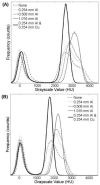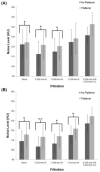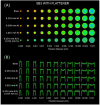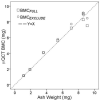Beam hardening artifacts in micro-computed tomography scanning can be reduced by X-ray beam filtration and the resulting images can be used to accurately measure BMD
- PMID: 19651256
- PMCID: PMC2783193
- DOI: 10.1016/j.bone.2009.07.078
Beam hardening artifacts in micro-computed tomography scanning can be reduced by X-ray beam filtration and the resulting images can be used to accurately measure BMD
Abstract
Bone mineral density (BMD) measurements are critical in many research studies investigating skeletal integrity. For pre-clinical research, micro-computed tomography (microCT) has become an essential tool in these studies. However, the ability to measure the BMD directly from microCT images can be biased by artifacts, such as beam hardening, in the image. This three-part study was designed to understand how the image acquisition process can affect the resulting BMD measurements and to verify that the BMD measurements are accurate. In the first part of this study, the effect of beam hardening-induced cupping artifacts on BMD measurements was examined. In the second part of this study, the number of bones in the X-ray path and the sampling process during scanning was examined. In the third part of this study, microCT-based BMD measurements were compared with ash weights to verify the accuracy of the measurements. The results indicate that beam hardening artifacts of up to 32.6% can occur in sample sizes of interest in studies investigating mineralized tissue and affect mineral density measurements. Beam filtration can be used to minimize these artifacts. The results also indicate that, for murine femora, the scan setup can impact densitometry measurements for both cortical and trabecular bone and morphologic measurements of trabecular bone. Last, when a scan setup that minimized all of these artifacts was used, the microCT-based measurements correlated well with ash weight measurements (R(2)=0.983 when air was excluded), indicating that microCT can be an accurate tool for murine bone densitometry.
Figures







References
-
- Blake GM, Fogelman I. Methods and Clinical Issues in Bone Densitometry and Quantitative Ultrasonometry. In: Bilezikian JP, Raisz LG, Rodan GA, editors. Principles of Bone Biology. 2nd ed. Academic Press; San Diego: 2002. pp. 1573–1585.
-
- Genant HK, Faulkner KG, Gluer CC, Engelke K. Bone densitometry: current assessment. Osteoporos Int. 1993;3(Suppl 1):91–7. - PubMed
-
- Bolotin HH. DXA in vivo BMD methodology: An erroneous and misleading research and clinical gauge of bone mineral status, bone fragility, and bone remodelling. Bone. 2007;41:138–54. - PubMed
-
- Martin DE, Severns AE, Kabo JM. Determination of mechanical stiffness of bone by pQCT measurements: correlation with non-destructive mechanical four-point bending test data. J Biomech. 2004;37:1289–93. - PubMed
-
- Lochmuller EM, Lill CA, Kuhn V, Schneider E, Eckstein F. Radius bone strength in bending, compression, and falling and its correlation with clinical densitometry at multiple sites. J Bone Miner Res. 2002;17:1629–38. - PubMed
Publication types
MeSH terms
Substances
Grants and funding
LinkOut - more resources
Full Text Sources
Other Literature Sources
Medical
Research Materials
Miscellaneous

